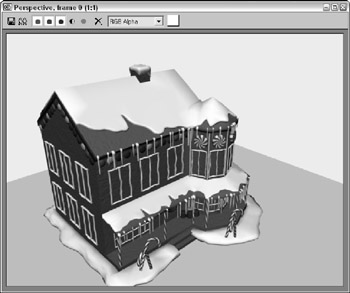Using the Rendered Frame Window
The Rendered Frame Window is a temporary window that holds any rendered images. Often when developing a scene, you want to test-render an image to view the shadows or transparency not visible in the viewports. The Rendered Frame Window, shown in Figure 43.10, enables you to view these test renderings without saving any data to the network or hard drive.

Figure 43-10: The Rendered Frame Window displays rendered images without saving them to a file.
This buffer opens when you select the Rendered Frame Window option and click the Render button in the Render Scene dialog box. You can also view images from a local hard drive or a network drive in the Rendered Frame Window using the File View Image File menu command.
To zoom in on the buffer, hold down the Ctrl key and click the buffer. Right-click while holding down the Ctrl key to zoom out. The Shift key enables you to pan the buffer image. You can also use the mouse wheel (if you have a scrolling mouse) to zoom and pan within the frame buffer.
| Tip | You can zoom and pan the image while it is rendering. |
 At the top of the frame buffer dialog box are several icon buttons. The first is the Save Bitmap button, which enables you to save the current frame buffer image.
At the top of the frame buffer dialog box are several icon buttons. The first is the Save Bitmap button, which enables you to save the current frame buffer image.
 The Clone Rendered Frame Window button creates another frame buffer dialog box. Any new rendering is rendered to this new dialog box, which is useful for comparing two images.
The Clone Rendered Frame Window button creates another frame buffer dialog box. Any new rendering is rendered to this new dialog box, which is useful for comparing two images.
The next four buttons enable the red, green, blue, and alpha channels. The alpha channel holds any transparency information for the image. The alpha channel is a grayscale map, with black showing the transparent areas and white showing the opaque areas. Next to the Display Alpha Channel button is the Monochrome button, which displays the image as a grayscale image.
 The Clear button erases the image from the window.
The Clear button erases the image from the window.
The Channel Display drop-down list lets you select the channel to display. The color swatch at the right shows the color of the currently selected pixel. You can select new pixels by right-clicking and holding on the image. This temporarily displays a small dialog box with the image dimensions and the RGB value of the pixel directly under the cursor. The color in the color swatch can then be dragged and dropped in other dialog boxes such as the Material Editor.